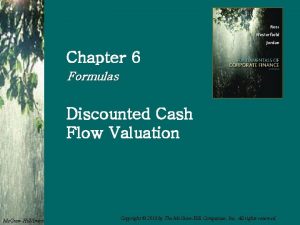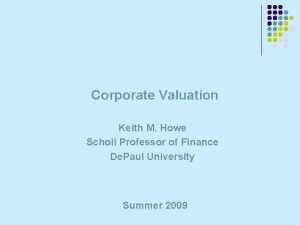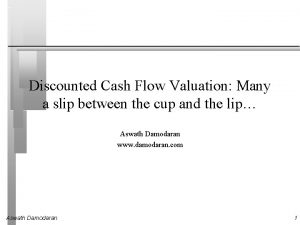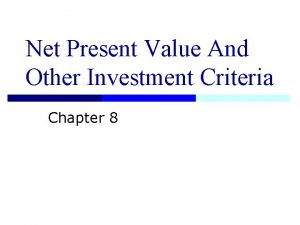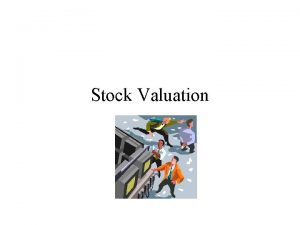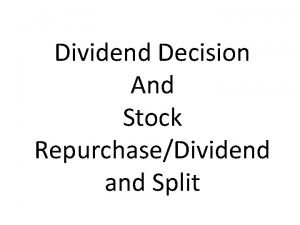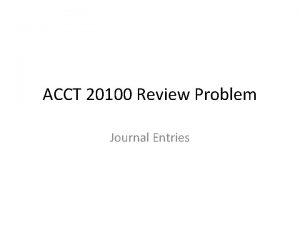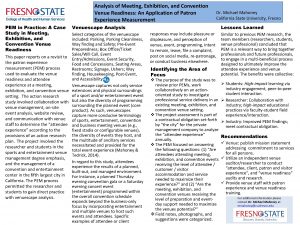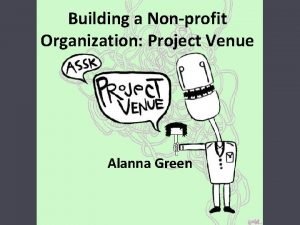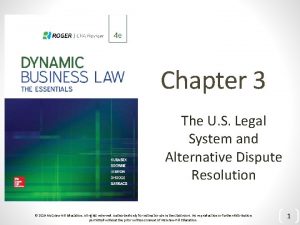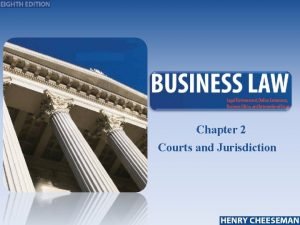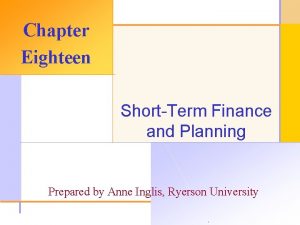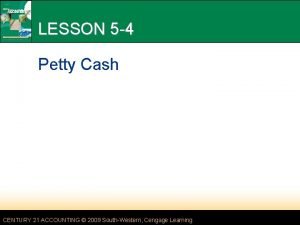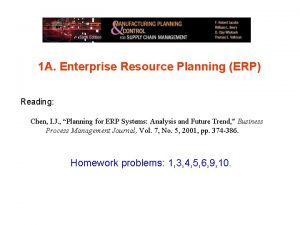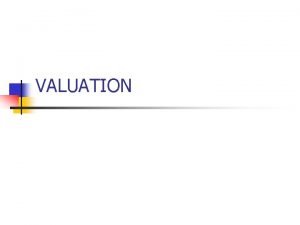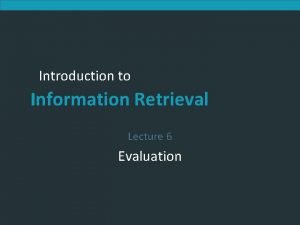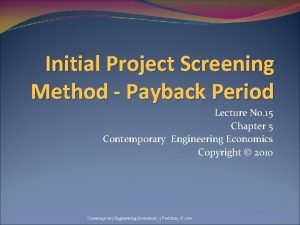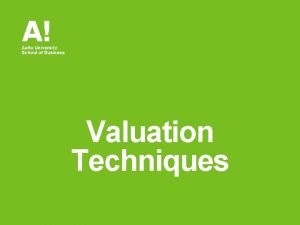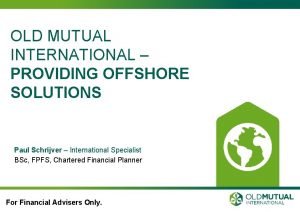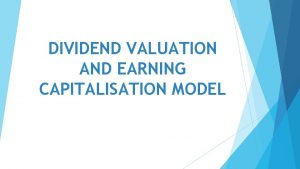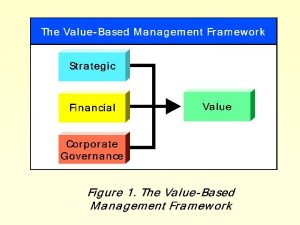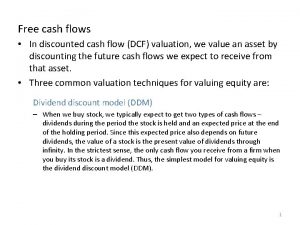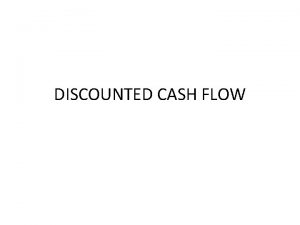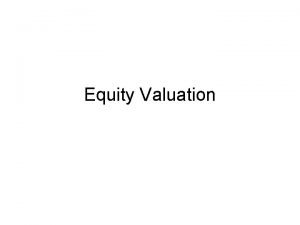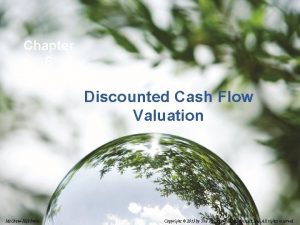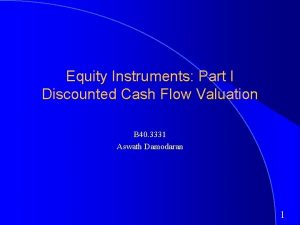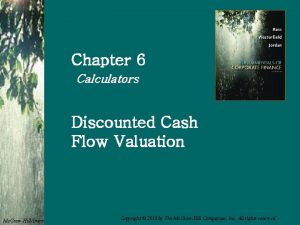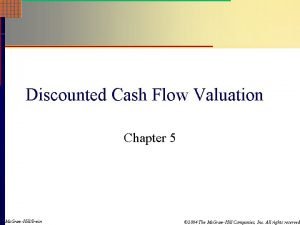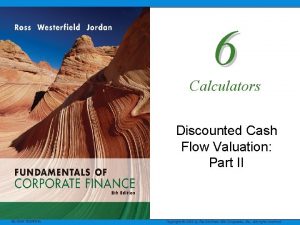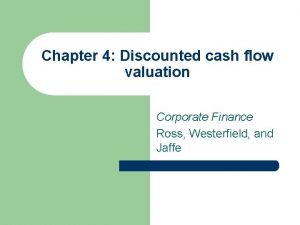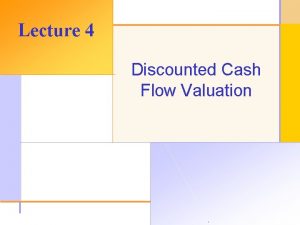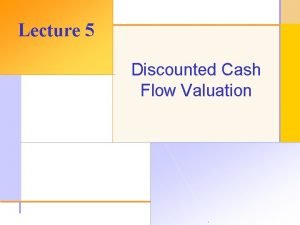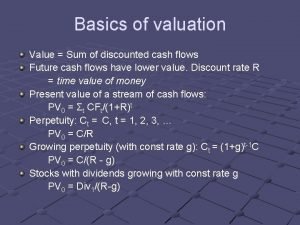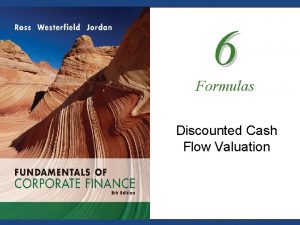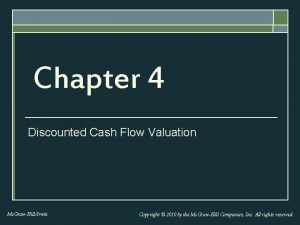DISCOUNTED DIVIDEND VALUATION Presenter Venue Date DISCOUNTED CASH














































- Slides: 46

DISCOUNTED DIVIDEND VALUATION Presenter Venue Date

DISCOUNTED CASH FLOW MODELS 2

CHOICE OF DISCOUNTED CASH FLOW MODELS 3

VALUING COMMON STOCK USING A MULTI-PERIOD DDM 4

EXAMPLE: VALUING COMMON STOCK USING A MULTPERIOD DDM 0 D P 1 2 3 $1. 00 $1. 05 $1. 10 $20. 00

EXAMPLE: VALUING COMMON STOCK USING A MULTPERIOD DDM

VALUING COMMON STOCK USING THE GORDON GROWTH MODEL

EXAMPLE: VALUING COMMON STOCK USING THE GORDON GROWTH MODEL Risk-free rate 3. 0% Equity risk premium 6. 0% Beta 1. 20 Current dividend Dividend growth rate Current stock price $2. 00 5. 0% $24. 00

VALUING COMMON STOCK USING THE GORDON GROWTH MODEL

EXAMPLE: VALUING PREFERRED STOCK

EXAMPLE: CALCULATING THE IMPLIED GROWTH RATE USING THE GORDON GROWTH MODEL Using the previous common stock example and the current stock price of $24, what is the implied growth rate?

CALCULATING THE IMPLIED REQUIRED RETURN USING THE GORDON GROWTH MODEL

EXAMPLE: CALCULATING THE IMPLIED REQUIRED RETURN USING THE GORDON GROWTH MODEL Using the previous common stock example and the current stock price of $24, what is the implied required return?

PRESENT VALUE OF GROWTH OPPORTUNITIES

PRESENT VALUE OF GROWTH OPPORTUNITIES

EXAMPLE: PRESENT VALUE OF GROWTH OPPORTUNITIES Stock price $80. 00 Expected earnings $5. 00 Required return on stock 10%

EXAMPLE: PRESENT VALUE OF GROWTH OPPORTUNITIES

EXAMPLE: PRESENT VALUE OF GROWTH OPPORTUNITIES

USING THE GORDON GROWTH MODEL TO DERIVE A JUSTIFIED LEADING P/E

USING THE GORDON GROWTH MODEL TO DERIVE A JUSTIFIED TRAILING P/E

EXAMPLE: USING THE GORDON GROWTH MODEL TO DERIVE A JUSTIFIED P/E Stock price $50. 00 Trailing earnings per share $4. 00 Current dividends per share $1. 60 Dividend growth rate 5. 0% Required return on stock 9. 0%

EXAMPLE: USING THE GORDON GROWTH MODEL TO DERIVE A JUSTIFIED LEADING P/E

EXAMPLE: USING THE GORDON GROWTH MODEL TO DERIVE A JUSTIFIED TRAILING P/E

ISSUES USING THE GORDON GROWTH MODEL Strengths Limitations Simple and applicable to stable, mature firms Not applicable to non-dividend -paying firms Can be applied to entire markets g must be constant g can be estimated using macro data Stock value is very sensitive to r – g Can be applied to firms that repurchase stock Most firms have nonconstant growth in dividends

CHOICE OF DISCOUNTED CASH FLOW MODELS • Rapidly earnings • Heavy reinvestment • Small or no dividends Growth Transition • Earnings growth slows • Capital reinvestment slows • FCFE & dividends • ROE = r • Earnings & dividends growth matures • Gordon growth model useful Maturity

GENERAL TWO-STAGE DDM

EXAMPLE: GENERAL TWO-STAGE DDM Current dividend = $2. 00 Growth for next three years = 15 percent Long-term growth = 4 percent Required return = 10 percent

EXAMPLE: GENERAL TWO-STAGE DDM Step 1: Calculate the first three dividends: • D 1 = $2. 00 x (1. 15) = $2. 30 • D 2 = $2. 30 x (1. 15) = $2. 6450 • D 3 = $2. 6450 x (1. 15) = $3. 0418 Step 2: Calculate the year 4 dividend: • D 4 = $3. 0418 x (1. 04) = $3. 1634 Step 3: Calculate the value of the constant growth dividends: • V 3 = $3. 1634 / (0. 10 – 0. 04) = $52. 7237

EXAMPLE: GENERAL TWO-STAGE DDM

EXAMPLE: GENERAL TWO-STAGE DDM • Using the previous example, now we’ll use the trailing P/E to determine the terminal value • The D 4 is $3. 1634 • Assume also that the projected P/E is 13. 0 in year 4 and that the firm will pay out 60 percent of earnings as dividends • Year 4 earnings are then $3. 1634 / 0. 60 = $5. 2724 • The stock price in year 4 is then $5. 2724 × 13 = $68. 54

EXAMPLE: GENERAL TWO-STAGE DDM

TWO-STAGE H-MODEL

EXAMPLE: TWO-STAGE H-MODEL Current dividend $3. 00 gs 20% g. L H Required return on stock Current stock price 6% 5 10% $120

EXAMPLE: TWO-STAGE H-MODEL

SOLVING FOR THE REQUIRED RETURN USING THE TWO-STAGE H-MODEL

EXAMPLE: THREE-STAGE MODEL • Firm pays a current dividend of $1. 00 • Growth rate is 20 percent for next two years • Growth then declines over six years to stable rate of 5 percent • Required return is 10 percent • Current stock price is $50

THREE-STAGE MODEL Assumes three distinct growth stages: • First stage of growth • Second stage of growth • Stable-growth phase H-model can be used for last two stages if growth declines linearly

THREE-STAGE MODEL EXAMPLE

ESTIMATING THE GROWTH RATE g = b × ROE Industry or Macroeconomic Average • Du. Pont formula • ROE = r • ROE = industry ROE

THE SUSTAINABLE GROWTH RATE g b ROE

THE DUPONT MODEL

EXAMPLE: DUPONT MODEL Net profit margin 5. 00% Total asset turnover 1. 5 Equity multiplier 2. 0 Retention ratio 60%

EXAMPLE: DUPONT MODEL

SUMMARY Choice of Discounted Cash Flow Models • Dividend discount models, free cash flow models, residual income models • Dividend models most appropriate for • Mature, profitable, dividend-paying firms • Noncontrolling shareholder perspective Gordon Growth Model • Assumes constant g and r > g • Applicable to mature, stable firms • Estimated value very sensitive to r – g denominator

SUMMARY Uses of Gordon Growth Model • • Preferred stock valuation where g = 0 PVGO – Value from future growth Justified leading and trailing P/Es Implied r and g Phases of Growth • Growth • Transition • Maturity

SUMMARY Multistage Models • General two-stage model: growth abruptly declines • H-model: growth gradually declines • Three-stage model: can utilize general or H-model Sustainable Growth Rate • g = Retention ratio × ROE • Du. Pont analysis: • ROE = Profit margin × Asset turnover × Equity multiplier
 Chapter 6 discounted cash flow valuation
Chapter 6 discounted cash flow valuation Dividend policy example
Dividend policy example Date time venue invitation
Date time venue invitation Discounted cash
Discounted cash Discounted cash flow
Discounted cash flow Net present value discounted cash flow
Net present value discounted cash flow Generalized dividend valuation model
Generalized dividend valuation model Fixed income valuation
Fixed income valuation What is the dividend
What is the dividend Stock split formula
Stock split formula Cash dividend received journal entry
Cash dividend received journal entry Venue readiness
Venue readiness Organization building venue
Organization building venue Jurisdiction vs venue
Jurisdiction vs venue Swot analysis of event venue
Swot analysis of event venue Proposal venue
Proposal venue Jurisdiction vs venue
Jurisdiction vs venue Event contents
Event contents Stonehenge in parys
Stonehenge in parys Layout perusahaan jasa
Layout perusahaan jasa L'heure est venue ou les vrais adorateurs
L'heure est venue ou les vrais adorateurs National gallery venue hire
National gallery venue hire Vision of work immersion
Vision of work immersion Cash to cash cycle time
Cash to cash cycle time Paid cash to replenish the petty cash fund
Paid cash to replenish the petty cash fund Cash to cash cycle time
Cash to cash cycle time Accounting chapter 5 cash control systems answers
Accounting chapter 5 cash control systems answers What is cash in and cash out
What is cash in and cash out The essentials of effective budgeting do not include
The essentials of effective budgeting do not include Payback period uneven cash flows
Payback period uneven cash flows Discounted rate of return
Discounted rate of return How to calculate the discounted payback period
How to calculate the discounted payback period Normalized discounted cumulative gain
Normalized discounted cumulative gain Discounted payback period formula
Discounted payback period formula Justified trailing p/e
Justified trailing p/e Discounted gift trust 10 year charge
Discounted gift trust 10 year charge Old mutual wealth discounted gift trust
Old mutual wealth discounted gift trust Presenter media
Presenter media Asos cl
Asos cl Presenter title
Presenter title Exemple de conclusions
Exemple de conclusions Presenter's name
Presenter's name Name/title of presenter
Name/title of presenter Presentation name
Presentation name Model view presenter
Model view presenter Ctxsys.context
Ctxsys.context Thi pronunciation
Thi pronunciation
